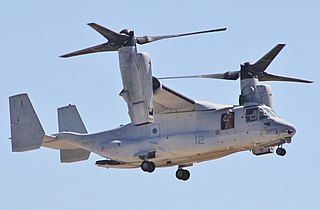
The Bell Boeing V-22 Osprey is an American multi-mission, tiltrotor military aircraft with both vertical takeoff and landing (VTOL) and short takeoff and landing (STOL) capabilities. It is designed to combine the functionality of a conventional helicopter with the long-range, high-speed cruise performance of a turboprop aircraft. The V-22 is operated by the United States and Japan, and is not only a new aircraft design, but a new type of aircraft that entered service in the 2000s, a tiltrotor compared to fixed wing and helicopter designs. The V-22 first flew in 1988 and after a long development was fielded in 2007. The design essentially combines the vertical takeoff ability of a helicopter, but the range of a fixed-wing airplane.
The CarterCopter is an experimental compound autogyro developed by Carter Aviation Technologies in the United States to demonstrate slowed rotor technology. On 17 June 2005, the CarterCopter became the first rotorcraft to achieve mu-1 (μ=1), an equal ratio of airspeed to rotor tip speed, but crashed on the next flight and has been inoperable since. It is being replaced by the Carter Personal Air Vehicle.

The Sikorsky CH-53E Super Stallion is a heavy-lift helicopter operated by the United States military. As the Sikorsky S-80, it was developed from the CH-53 Sea Stallion, mainly by adding a third engine, adding a seventh blade to the main rotor, and canting the tail rotor 20°. It was built by Sikorsky Aircraft for the United States Marine Corps. The less common MH-53E Sea Dragon fills the United States Navy's need for long-range minesweeping or airborne mine countermeasures missions, and performs heavy-lift duties for the Navy. The Sikorsky CH-53K King Stallion, which has new engines, new composite rotor blades, and a wider aircraft cabin, is set to replace the CH-53E and is beginning to enter service in the 2020s, but most of the Super Stallions are still in service as are the MH-53E Sea Dragons.
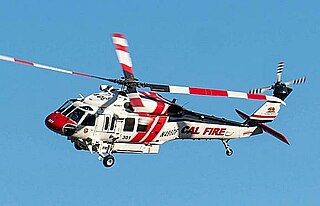
The Sikorsky S-70 is an American medium transport/utility helicopter family manufactured by Sikorsky Aircraft. It was developed for the United States Army in the 1970s, winning a competition to be designated the UH-60 Black Hawk and spawning a large family in U.S. military service. New and improved versions of the UH-60 have been developed since. Civilian versions, and some military versions, are produced under various S-70 model designations.

On a helicopter, the main rotor or rotor system is the combination of several rotary wings with a control system, that generates the aerodynamic lift force that supports the weight of the helicopter, and the thrust that counteracts aerodynamic drag in forward flight. Each main rotor is mounted on a vertical mast over the top of the helicopter, as opposed to a helicopter tail rotor, which connects through a combination of drive shaft(s) and gearboxes along the tail boom. The blade pitch is typically controlled by the pilot using the helicopter flight controls. Helicopters are one example of rotary-wing aircraft (rotorcraft). The name is derived from the Greek words helix, helik-, meaning spiral; and pteron meaning wing.
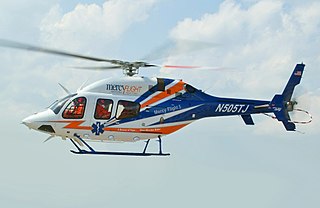
The Bell 429 GlobalRanger is a light, twin-engine helicopter developed by Bell Helicopter and Korea Aerospace Industries. The first flight of the prototype took place on February 27, 2007, and the aircraft received type certification on July 1, 2009. The Bell 429 is capable of single-pilot IFR and Runway Category A operations.

The Airbus Helicopters H145 is a twin-engine light utility helicopter developed and manufactured by Airbus Helicopters. Originally designated as the BK 117, the H145 is based upon the MBB/Kawasaki BK 117 C1, which became a part of the combined Eurocopter line-up in 1992 with the merger of Messerschmitt-Bölkow-Blohm's helicopter division of Daimler-Benz into Eurocopter. The helicopter was earlier named EC145; an updated version, EC145 T2, was renamed H145 in 2015. The helicopter had significant update in the 2020s, an updated version with a 5-blade main rotor and fenestron entered production.

A rotorcraft or rotary-wing aircraft is a heavier-than-air aircraft with rotary wings or rotor blades, which generate lift by rotating around a vertical mast. Several rotor blades mounted on a single mast are referred to as a rotor. The International Civil Aviation Organization (ICAO) defines a rotorcraft as "supported in flight by the reactions of the air on one or more rotors".

The EurocopterUH-72 Lakota is a twin-engine helicopter with a single, four-bladed main rotor. The UH-72 is a militarized version of the Eurocopter EC145, built by American Eurocopter, a division of Airbus Group, Inc. Several hundred UH-72 of various types have entered service by the 2020s since their introduction in 2006.
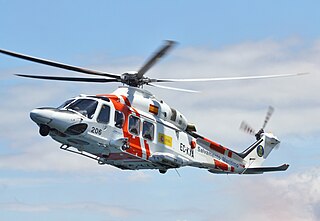
The AgustaWestland AW139, now known as the Leonardo AW139, is a 15-seat medium-sized twin-engined helicopter developed and produced by the Anglo-Italian helicopter manufacturer AgustaWestland, now part of Leonardo. It is marketed at several different roles, including VIP/corporate transport, military use, offshore transport, firefighting, law enforcement, search and rescue, emergency medical service, disaster relief, and maritime patrol.

A helicopter is a type of rotorcraft in which lift and thrust are supplied by horizontally spinning rotors. This allows the helicopter to take off and land vertically, to hover, and to fly forward, backward and laterally. These attributes allow helicopters to be used in congested or isolated areas where fixed-wing aircraft and many forms of short take-off and landing (STOL) or short take-off and vertical landing (STOVL) aircraft cannot perform without a runway.

The Sikorsky X2 is an experimental high-speed compound helicopter with coaxial rotors, developed by Sikorsky Aircraft, that made its first flight in 2008 and was officially retired in 2011.
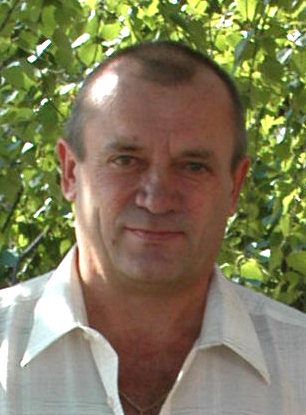
Mykola Mykolayovych Melnyk, also known as Nikolai Melnik, was a Soviet-Ukrainian pilot and liquidator hero renowned for his high-risk helicopter mission on the dangerously-radioactive Chernobyl Nuclear Power Plant building immediately after the 1986 Chernobyl disaster.

The Baldwin Mono Tiltrotor project is a research effort into a tiltrotor aircraft that uses only one rotor. Like other tiltrotor configurations, the mono tiltrotor combines the vertical lift capability and structural efficiency of a helicopter with the speed and range of a fixed-wing aircraft.

Future Vertical Lift (FVL) is a plan to develop a family of military helicopters for the United States Armed Forces. Five different sizes of aircraft are to be developed, sharing common hardware such as sensors, avionics, engines, and countermeasures. The U.S. Army has been considering the program since 2004. FVL is meant to develop replacements for the Army's UH-60 Black Hawk, AH-64 Apache, CH-47 Chinook, and OH-58 Kiowa helicopters. The precursor for FVL is the Joint Multi-Role (JMR) helicopter program.

The AgustaWestland AW189 is a twin-engined, super-medium-lift helicopter manufactured by Leonardo S.p.A. It is derived from the AW149, and shares similarities with the AW139 and AW169.
Salute to Excellence is a category of awards issued by the Helicopter Association International since 1960, "for outstanding achievements in the international helicopter community".

The Bell 525 Relentless is an American super-medium-lift helicopter, under development by Bell Textron. The Bell 525 was unveiled at the 2012 Heli-Expo in Dallas, Texas in February 2012. The helicopter first flew on 1 July 2015. It is designed to transport up to 19 passengers. The aircraft is the first fly-by-wire civilian aircraft and suffered a crash of its prototype, and is still slowly working towards certification. As of 2024 Bell is still working towards completing flight certification but already has its first order.

Charles "Chuck" Aaron is an American pilot notable for being one of a handful of pilots holding an FAA waiver to perform aerobatics in a helicopter in the United States, and one of only four such pilots in the entire world. In 1980, Aaron worked on the air rescue program for NASA's Space Shuttle, and he founded his own company, FX Helicopters in Westlake Village, California in 1997. Aaron announced his retirement from the airshow circuit in 2015 and made his last performance for Red Bull at the November 2015 Red Bull Air Race World Championship in Las Vegas.














